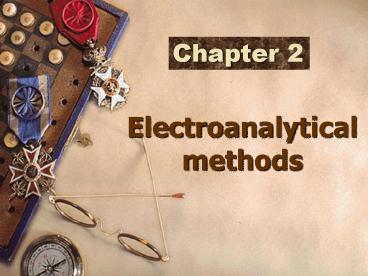Electroanalytical methods - PowerPoint PPT Presentation
1 / 34
Title: Electroanalytical methods
1
Chapter 2
Electroanalytical methods
2
Electroanalytical methods
- Electrogravimetry
- Coulometry
- Potentiometry
- Voltammetry
3
Potentiometry
Fundamentals of potentiometry
Reference electrodes
Indicator and ion selective electrodes
Instrumentation and measurement of cell
electromotive force (e.m.f)
4
Fundamentals of potentiometry
When a metal is immersed in a solution containing
its own ions, the potential difference is
established between the metal and the solution
Oxne Red
5
Fundamentals of potentiometry
M n ne M
? ? ? (RT/nF) ln ?Mn
Nernst equation
6
Fundamentals of potentiometry
Indicator electrode
Reference electrode
Solution
Cell
7
Fundamentals of potentiometry
M M n reference electrode
Liquid junction potential
E ? () - ? (-) ? L
E ? () - ? (-) ? r - ? ? - (RT/nF) ln
?Mn
8
Reference electrodes
Hydrogen electrode
Calomel electrode
Silver silver chloride electrode
9
Calomel electrode
10
Calomel electrode
HgHg2Cl2,KCl(xM)? Hg2Cl2(s) 2e 2Hg(l) 2Cl-
Electrode potential
? ? ? Hg2Cl2 / Hg (RT/nF) ln (1/ ?Cl-2)
? ? Hg2Cl2 / Hg - 0.059 lg ?Cl-
11
Silver silver chloride electrode
AgAgCl,KCl(xM)? AgCl(s) e Ag(s)Cl-
Electrode potential
? ? ? AgCl / Ag (RT/nF) ln (1/ ?Cl-) ?
? AgCl / Ag - 0.059 lg ?Cl-
12
Indicator and ion selective electrodes
Indicator electrode
---The potential depends on the activity of a
particular ionic species which it is desired to
quantify
13
Indicator and ion selective electrodes
Electrode of the first kind
Electrode of the second kind
Metal electrode
Inert electrode
The glass electrode
Crystalline membrane electrode
Membrane electrode
Biochemical electrode
14
Indicator and ion selective electrodes
Electrode of the first kind
---The ion to be determined is directly involved
in the electrode reaction
Metal M immersed in a solution of M n ion
? ? ? M n / M (RT/nF) ln ?Mn
15
Indicator and ion selective electrodes
Electrode of the second kind
Silver silver chloride electrode
--- coating a silver wire with silver choloride
AgCl(s) e Ag(s)Cl-
? ? ? AgCl / Ag (RT/nF) ln (1/ ?Cl-) ?
? AgCl / Ag - 0.059 lg ?Cl-
16
Inert electrode
---An inert electrode (Pt) is place in a system
containing both an oxidizing agent and its
reduction product
Fe 3 e Fe 2
? ? ? Fe 3 / Fe2 (RT/nF) ln (?Fe3 / ?Fe2)
17
The glass electrode
18
The glass electrode
Composition
SiO2 72 Na2O 22 CaO 6
SiO2 63 Li2O 28 Cs2O 2 BaO 4 La2O3 3
19
The glass electrode
Theory
--- Ion exchange process
? glass K (RT/nF) ln ?H K
0.059 pH
20
The glass electrode
properties
Can be used in the presence of strong oxidants
and reductants
Can be used in viscous media
Can be used in the presence of proteins
21
The glass electrode
properties
High resistance
Acid error and alkaline error
22
Crystalline membrane electrode
composition
Crystal of lanthanum fluoride
0.1 mol/L NaF 0.1 mol/L NaCl
Silver silver chloride electrode
Lanthanum fluoride eletrode
23
Crystalline membrane electrode
Theory
Lattice defect
? membrane K - (RT/nF) ln ?F-
K 0.059 lg ?F-
24
Crystalline membrane electrode
properties
Detection limit 10-7 mol/L
Interference OH-
pH range 5 - 6
25
Gas sensing electrode
NH3 NH4Cl
CO2 NaHCO3
NO2 NaNO2
26
Biochemical electrode
Urea electrode
urease
CO(NH2)2 H2O 2H 2NH4 CO2
27
Instrumentation
Determination of pH
28
Determination of pH
Glass electrode
Solution X
SCE
E ? SCE - ? glass ? SCE (? ? AgCl / Ag
K (RT/nF) ln ?H)
E K (2.303 RT /F) pH
29
Determination of pH
E x K x (2.303 RT /F) pH x
E s K s (2.303 RT /F) pH s
K x K s
pH x pH s (E x - E s) F/2.303RT
--- Operational definition
30
Determination of pH
pH standard solution (25 Cº)
31
Determination of fluoride
? membrane K (0.059/n) lg ?
Calibration curve
Standard addition
32
Determination of fluoride
Calibration curve
Standard solutions
Total ionic strength adjustment buffer(TISAB)
Ionic strength
NaCl
pH
NaAc - HAc
Interference
Sodium citrate
33
Determination of fluoride
Standard addition
E1 kc k log y1 C1
E2 kc k log y1 (V1C1 V2Cs)/(V1 V2)
E2 - E1 k log (V1C1 V2Cs)/ C1(V1 V2)
C1 Cs/(10 ? E/k(1V1/V2) V1/V2)
34
The end































